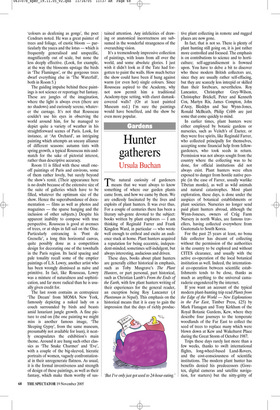Hunter gatherers
Ursula Buchan
The natural curiosity of gardeners means that we want always to know something of where our garden plants came from, and how we came by them. We are endlessly fascinated by the lives and exploits of plant hunters. It was ever thus. For a couple of centuries there has been a literary sub-genre devoted to the subject: books written by plant explorers — I am thinking of Reginald Farrer and Frank Kingdon Ward, in particular — who wrote well enough to enthral and excite an audience stuck at home. Plant hunters acquired a reputation for being eccentric, independent-minded, sometimes self-indulgent, but always interesting, audacious and driven.
These days, books about plant hunters are generally either historical in emphasis, such as Toby Musgrave’s The Plant Hunters, or part personal, part historical, such as Christian Lamb’s From the Ends of the Earth, with few plant hunters writing of their experiences for the general reader, an exception being Roy Lancaster (A Plantsman in Nepal). This emphasis on the historical means that it is easy to gain the impression that the days of richly produc tive plant collecting in remote and rugged places are now gone.
In fact, that is not so. There is plenty of plant hunting still going on, it is just rather more controlled and focused. The emphasis is on contributions to science and to horticulture; self-aggrandisement is frowned upon. You have to delve a bit to discover who these modern British collectors are, since they are usually rather self-effacing, but they are scarcely less intrepid or skilled than their forebears, nevertheless. Roy Lancaster, Christopher Grey-Wilson, Christopher Brickell, Peter and Kenneth Cox, Martyn Rix, James Compton, John d’Arcy, Bleddyn and Sue Wynn-Jones, Ronald McBeath, Philip Cribb are just some that come quickly to mind.
In earlier times, plant hunters were either employed by botanic gardens or nurseries, such as Veitch’s of Exeter, or they were free spirits, like Reginald Farrer, who collected principally for themselves, accepting some financial help from fellowgardeners, who took seeds in return. Permission was not always sought from the country where the collecting was to be done, for official institutions did not always exist. Plant hunters were often exposed to danger from hostile native people (in the case of Farrer, usually warlike Tibetan monks), as well as wild animals and natural catastrophes. Most plant exploration, these days, is done under the auspices of botanical establishments or plant societies. Nurseries no longer send paid plant hunters abroad, although the Wynn-Joneses, owners of Crûg Farm Nursery in north Wales, are famous travellers, having collected everywhere from Guatemala to South Korea.
For the past 25 years at least, no bona fide collector has dreamt of collecting without the permission of the authorities in the country to be explored and without CITES clearance, and usually with the active co-operation of the local botanical institution as well. Indeed, the international co-operation between scientific establishments tends to be close, thanks as much as anything to the universal camaraderie engendered by the internet.
If you want an account of the typical modern plant-hunting trip read Plants from the Edge of the World — New Explorations in the Far East, Timber Press, £25) by Mark Flanagan and Tony Kirkham of the Royal Botanic Gardens, Kew, where they describe four journeys to the temperate woodlands of the Far East to collect the seed of trees to replace many which were blown down at Kew and Wakehurst Place during the Great Storm of October 1987.
Trips these days rarely last more than a few weeks, thanks to swift international flights, long-wheel-based Land-Rovers, and the cost-consciousness of scientific institutions. The modern plant hunter has benefits denied his predecessors (Goretex, digital cameras and satellite navigation, for starters) but the nitty-gritty of plant hunting and collection — pressing specimens, changing the drying paper of plants already pressed, writing notes and diaries, cleaning and labelling seed — at the end of each hard day is the same as ever. Carelessness about discomfort, meticulous attention to detail, inexhaustible optimism, patience and sound botanical knowledge; these are the marks of a good plant hunter, of whatever era. Protecting health in unpromising regions and dreadful weather remains the same keeping your feet dry, your mind clear when crossing gorges on a high rope bridge, dodging rock falls and avoiding road accidents, bandits and snakes.
Back home, the field notes must be printed, herbarium specimens sent to botanical gardens, seed cleaned and live plants, if any, distributed. Those of possible garden-worthiness have to be sent to nurseries for evaluation, naming, bulking up and eventual sale. Contemporary plant collectors are responsible for introducing such beautiful garden plants as Corydalis flexuosa ‘China Blue’, Daphne bholua ‘Gurkha’, Veronica peduncularis ‘Georgia Blue’, Actaea taiwanensis and Salvia patens ‘Guanajuato’.
In one very important particular, however, contemporary plant hunting differs from that which went on before the war. The accelerating destruction of habitats, and the pressing need to conserve rare and endangered species, have given this task a new urgency. You may not hear a great deal about modern plant hunters but, by golly, we need them.


























































 Previous page
Previous page